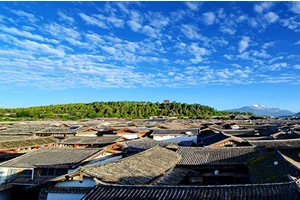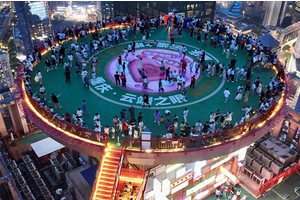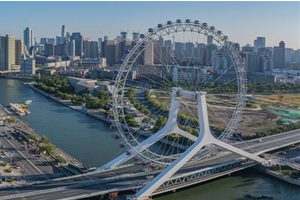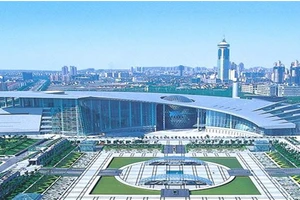Zhangjiajie Tourism Bureau Tel
Zhangjiajie, formerly known as Dayong City, was established as a prefecture-level city with the approval of the State Council in May 1988, and was renamed as Zhangjiajie City in April 1994. It is located in the northwest border of Hunan, in the middle and upper reaches of the Lishui River, with Wuling Mountain Range across it. The city has jurisdiction over Yongding and Wulingyuan districts and Cili and Sangzhi counties. It has a total area of 9516 square kilometers and a total population of 1.6 million, of which Tujia ethnic minorities account for 77% of the total population. Zhangjiajie has a pleasant climate, which belongs to the subtropical mountain prototype monsoon humid climate, with an average annual temperature of 16.8℃. It is an ideal place for sightseeing, vacation and recuperation.
Zhong Ling, Zhangjiajie, is beautiful and natural, with a complete range of tourism resources, distinctive features and high grade.
Zhangjiajie is a masterpiece of nature and a paradise for all kinds of wild animals and plants. There are natural landscapes in chinese odyssey, such as Zhangjiajie National Forest Park, the first national forest park in China, Wulingyuan Scenic Area, a world natural heritage and a world geological park. In the scenic area, there are many peaks competing for beauty, dangerous gorges and deep streams, waterfalls flowing springs, cliff trees retreating, lingcao spreading all over the quilt, birds singing and apes singing, integrating "peaks, forests, caves, lakes and waterfalls" into one, and integrating "seclusion, wildness, strangeness, beauty and danger" into one, which can be described as "five steps to one scene, ten steps to one sky".
Around the core scenic spot of Wulingyuan, there are many unique natural ecological landscapes in Zhangjiajie. For example, Jiutian Cave, the first cave in Asia, Wulei Mountain, the soul of Wuling Mountain, Badagong Mountain National Nature Reserve, and Maoyan River rafting.
Thanks to the former "bred in an inner chamber, with no one knowing her" and the simple nature of Zhangjiajie people who love and protect nature, Zhangjiajie is like a pure land on earth and a paradise in the modern society where conflicts between man and nature continue. The city's forest coverage rate reached 67%. The forest coverage rate of the scenic spot is as high as 98%, which is a veritable natural oxygen bar. The negative ion content in the atmosphere here is 100 to 400 times higher than that in the general environment, and the number of days when the air quality reaches Grade II or above is nearly 90% every year, among which the scenic spots have stably reached the national first-class standard. More than 90% of the sections of the main waters meet the national standards of Class I and II surface water.
Zhangjiajie is also a "paradise for wild animals" and a "gene bank for plants". There are 31 species of endemic plants in 15 families and 7 species of endemic wild animals. In 2006, biologists discovered another new species in China-Rhododendron Tianmenshan in Zhangjiajie. In Zhangjiajie Scenic Area, you can easily find clouded leopard, macaque, forest musk deer, wild boar, civet cat, yellow-bellied horned pheasant, pangolin, etc. Walking through the dense forest, giant salamander (commonly known as giant salamander) playing in the clear stream and mountain stream, and dove flower (scientific name Davidia involucrata) known as "living fossil of plants" dancing against the leaves, and
Zhangjiajie is not only a famous scenic spot at home and abroad, but also an old revolutionary base area. It is the hometown of Marshal He Long and the starting point of the Long March of the Red Second Army. In the long-term revolutionary struggle, more than 100,000 people in Zhangjiajie participated in the Red Army and local armed forces, engaged in the struggle between blood and fire, and as many as 20,000 martyrs died heroically for the revolution. It can be said that the mountains and rivers of Zhangjiajie are full of footprints of Red Army soldiers and revolutionary masses, and the red blood of revolutionary ancestors is everywhere.
Zhangjiajie actively responded to the call of the CPC Central Committee and the State Council to vigorously develop the red tourism industry, and took the development of red tourism as the focus of tourism work, and formulated the "Zhangjiajie Red Tourism Development Plan for 2004-2010", focusing on creating a number of red tourism scenic spots and routes, and launching a series of products combining red tourism and green eco-tourism, so that tourists can enjoy the natural scenery while receiving revolutionary traditional education, and get real feelings, good incentives and beautiful enjoyment. At present, the "Zhangjiajie-Sangzhi-Yongshun-Jishou-Tongren" route has been included in the list of 30 national red tourism boutique routes; He Long's former residence and memorial hall in Sangzhi County are listed in 100 "Red Tourism Classic Scenic Spots" in China. Yongding county Xiang-E-Chuan-Qian Soviet Revolutionary Memorial Hall is one of the bases of patriotism education in China. Kuzhuhe Town and Maoyan Gorge in the Jiutian Cave Scenic Area of Maoyan River, Tianzishan He Long Park and Jin Bianxi in the core scenic area are all places where the Red Army had been active and fought.
Zhangjiajie has a long history. As early as the Neolithic Age, human beings flourished. For thousands of years, people of 33 ethnic groups, including Tujia, Bai, Miao and Han, have lived in harmony in this land. Numerous kinds of folk culture, simple and rich folk customs, wonderful and amazing national sports, unique national costumes, unique national diets, etc., constitute a unique and beautiful picture scroll, which complements the beautiful natural scenery of Zhangjiajie Scenic Area. In 2006, Sangzhi folk songs, Tujia waving dance, Maogusi dance and Tujia brocade skills were all selected into the list of China's intangible cultural heritage protection.
Zhangjiajie also has colorful cultural relics. According to statistics, there are 41 national first-class cultural relics, 186 second-class cultural relics, 1,183 third-class cultural relics, more than 20,000 cultural relics, more than 8,000 national cultural relics and more than 3,000 revolutionary cultural relics in the city. There are two state-level cultural relics protection units in the city: He Long Memorial Hall (including He Long's former residence) and Hunan-Hubei-Sichuan-Guizhou Soviet Memorial Hall. There are five provincial-level cultural relics protection units: Puguang Temple, Yuhuang Cave, the starting point of the Long March of the Red Second Army, Meihua Hall in xingguo temple, Laoyuanzi, etc. These historical and cultural products endow the beautiful and magnificent landscape of Zhangjiajie with soul, making the natural landscape dreamlike and more magical.
Zhangjiajie is named after Qishan and established as a city because of tourism. Since the establishment of the city, the municipal government of Zhangjiajie has unswervingly implemented the strategy of tourism-driven, and the city's tourism industry and tourism infrastructure construction have developed by leaps and bounds.
In recent years, Zhangjiajie City has seized the opportunity of the country's proactive fiscal and monetary policies, actively sought support, vigorously attracted investment, and accelerated the infrastructure construction of water conservancy, energy, transportation, communications, environmental protection and urban areas and scenic spots. Today, the installed capacity of hydropower in the city is 490,000 kilowatts. Posts and telecommunications have reached the advanced level in China. Formed a three-dimensional transportation system focusing on Zhangjiajie Lotus Airport, Zhangjiajie secondary train passenger station, highway network and standard tour route. The Lotus Airport has been expanded, international flights have been opened, and special tourist trains have been set up, and the expressway from Changsha to Zhangjiajie has been built. Twelve tourist areas (spots) have been developed, more than 30 tourist routes have been built, and more than 300 kilometers of tourist lanes have been laid. The Huangshizhai cableway, Tianzishan cableway, Shuihuan four sightseeing elevators and Tianmenshan cableway have been built successively, and the roads in scenic spots have also been upgraded. Roads from the urban area to various scenic spots and roads connecting different scenic spots have been completed and opened to traffic.
Zhangjiajie tourism industry is full of vitality. Almost every year, new tourist attractions are opened to the outside world, and new hotels and hotels are listed for business every month. There are 12 scenic spots in the city that have been rated as "100 scenic spots in Hunan that people like". New scenic spots such as Longwangdong and Laoyuanzi have been developed, the first-phase project of Jiangya Reservoir Tourist Wharf has been built, the drifting wharf and highway of Maoyan River and Suoshui have been rebuilt, and the development of Tianmen Mountain Scenic Area and Huanglongdong Square have progressed smoothly. There are more than 400 hotels in the city, including 73 star-rated hotels. There are 64 travel agencies, including 14 international agencies, with more than 3,300 guides in various languages, with a daily reception capacity of 80,000 people. There are 4 tourist transportation companies and 673 tourist vehicles. Zhangjiajie has been successively rated as "Forty Best Tourist Attractions in China", "National Civilized Scenic Area" and "Excellent Tourist City in China". Zhangjiajie has become a well-known tourist attraction at home and abroad.
Driven by tourism, the city's industry, agriculture and tertiary industry have made great progress. The industrial structure was further optimized, the economic benefits were significantly improved, the people's lives were significantly improved, and a major breakthrough was made in tackling poverty. Attracting investment has also achieved remarkable results, and gradually formed three major industries: green biomedicine with plant active extracts as the main, green tourism commodities with agricultural and forestry by-products, and green clean energy with comprehensive development of hydropower resources. Activities such as "International Forest Protection Festival", "Tourism Commodity Design Competition" and "Tourism Commodity Expo" held for several years have achieved good economic and social benefits. The production of tourism commodities has grown to 140 enterprises, with more than 2,220 varieties in 15 categories. In addition, relying on resources and ecological advantages, the city has developed 160,000 mu of production bases for off-season vegetables, kudzu roots, wild vegetables and other tourist commodities, and has embarked on a new road of agricultural industrialization with broad prospects and considerable benefits.
In 2006, Zhang Chunxian, secretary of Hunan Provincial Committee of the Communist Party of China, put forward "making Zhangjiajie into a world tourism boutique" during his inspection tour in Zhangjiajie. This is a new goal under the background of world economic integration and a new requirement from the height of world tourism development, which points out the direction for the development of Zhangjiajie tourism.
Focusing on the grand goal of building a "world tourism boutique", Zhangjiajie is committed to promoting the upgrading of tourism industry and urban management and construction. In 2006, the city took the creation of National AAAAA level tourist attraction as the starting point, and further strengthened the construction of tourism infrastructure. The new Zhangjiajie Railway Station, which is at the leading level in China, has been basically completed and will be put into operation, and the airport and airport port are being expanded. Advocating to provide humanized services for tourists, a number of advanced models of the national tourism industry have emerged successively, such as Zhao Mingjian, Huangshizhai Party Branch and Jin Bianxi Women's Cleaning Team. The activities of establishing national health city, garden city, best tourist city, environmental protection model city and forest city around urban construction are in full swing. Tourism exchanges and cooperation have been continuously strengthened. With the United States, France, Germany, South Korea, Japan and other countries and Huangshan, Jiuzhaigou, Guilin, Changsha, Changde and other tourist cities, the horizontal alliance is increasingly close. Using the platform of Central Expo, we will form alliances with 52 tourist cities in six provinces in central China to build harmonious tourism and promote the rise of Central China. In 2006, Zhangjiajie also successfully held the aerobatic performance of the Russian Air Force, the International Forest Protection Festival, the Tourism Commodities Fair and the first International Food and Culture Festival, which caused a sensation all over the world.
The innovation and development of Zhangjiajie tourism have yielded fruitful results. In 2006, Zhangjiajie received 16.75 million domestic and foreign tourists, including 1.27 million overseas tourists, and realized a tourism income of 7.94 billion yuan, which increased by 15.7 times, 112 times and 70.8 times respectively compared with the opening of Zhangjiajie Lotus Airport in 1994. The city's GDP is 12.7 billion yuan, and the growth rate continues to maintain the leading position in Xiangxi.
On September 22nd, 2006, the Fifth Party Congress of Zhangjiajie City loudly put forward "Hold high the great banner of Scientific Outlook on Development and strive to build a world tourism boutique", mobilizing the people of the whole city to make a fuss about the boutique, develop first-class tourism products, build first-class tourism facilities, create first-class tourism services, establish first-class tourism brands, and gradually realize the transformation of tourism products from a single sightseeing type to a compound sightseeing, leisure and holiday type, so as to make Zhangjiajie a tourist destination with international fame and influence.
Thousands of years old city, thousands of changes. The former Tianmen ancient county has become a new international tourist city today. Looking forward to the future, Zhangjiajie people will hold high the great banner of Scientific Outlook on Development, work together, create more brilliant achievements and move towards a better tomorrow.
Zhangjiajie Tourism Bureau has seven internal organs to ensure the efficient operation of all work:
Office (Legal Department): responsible for the overall daily operation, including message processing, meeting arrangement, file management, letters and visits, confidentiality and supervision. In addition, the section is also responsible for tourism information management, economic analysis, investigation, drafting important reports and policies, conducting legality review, handling administrative reconsideration and litigation, supervising tourism law enforcement, formulating industry standards, managing tourism information, assessing industrial development performance, and coordinating holiday tourism and the work of the office of the Municipal Tourism Working Committee.
Comprehensive Reform Coordination Section: undertakes the national comprehensive tourism reform pilot task, is responsible for regional cooperation and industry safety management, coordinates tourism traffic, handles cross-departmental affairs, and studies and implements tourism market regulation policies.
Market promotion section: responsible for formulating market development strategy, making publicity and promotion plan, organizing domestic and international tourism publicity and activities, guiding tourism product packaging and marketing, managing publicity, conducting market research and analysis, coordinating media publicity, organizing festival activities, and international tourism cooperation and exchange.
Industry Management Section: responsible for planning and supervision of travel agencies, star-rated hotels and social hotels, review and approval of travel agencies and management of service outlets, star rating, supervision of non-star hotels, and training and safety guidance in tourism professionals.
Industrial Development and Planning Department: responsible for the city's tourism development planning, guiding the construction of tourism products and the general survey of tourism resources, managing tourism projects, guiding foreign investment and social investment, coordinating the development of tourism commodities, guiding the construction of new formats and service standards, and guiding the construction of tourist areas and the work of tourism commodity enterprises.
Finance department: responsible for financial management of organs and directly affiliated units, state-owned assets management and procurement audit, tourism fund planning and management, tourism promotion and promotion fund co-ordination, tourism special fund management and statistical analysis.
Personnel Department: responsible for organization establishment, personnel and labor affairs, management of the party and the masses and retirees, guidance of human resources in the tourism industry, construction of spiritual civilization and construction of the organization team in the tourism window industry.
Party organizations, discipline inspection and supervision organs and group organizations shall be established in accordance with relevant regulations.
Extended data
According to the Notice of Zhangjiajie Municipal People's Government of Zhangjiajie Municipal Committee of the Communist Party of China on Printing and Distributing the Implementation Opinions on the Institutional Reform Plan of Zhangjiajie Municipal People's Government (Zhang Fa [2010] No.3) and the Notice of Zhangjiajie Municipal People's Government of Zhangjiajie Municipal Committee of the Communist Party of China on the Institutional Establishment of Zhangjiajie Municipal People's Government (Zhang Wei [2010] No.8), Zhangjiajie Tourism Bureau was established as the working department of the Municipal People's Government.
Prev: The best time to travel to Xiamen
Next: Petra tourism






